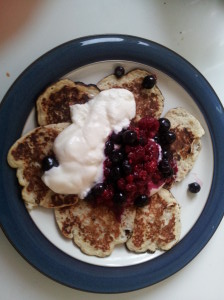One thing that most nutrition advice agrees on is that a low GI diet is better than a high GI diet. Even the NHS ME/CFS clinic I attended recommended a low GI diet, and they didn’t give much nutritional guidance at all.
What is the GI?
GI = Glycemic Index. The Glycemic Index is a measure of the speed at which carbohydrates break down in our digestive system into glucose. Glucose is indexed at 100 and all other foods are calculated against this. For example cornflakes, which contain mainly carbohydrate, are digested quickly and have a GI of 77, whilst yoghurt has a much lower GI of 14.
Why is it Important?
Some carbohydrates break down quickly and flood the bloodstream with glucose, others break down more slowly, only marginally increasing blood sugar levels. (High GI foods increase blood sugar faster and higher than low GI foods).
In my post on sugar I explained how sugar causes a spike in blood glucose levels. Our body responds to this by releasing insulin, which reduces the level of glucose by diverting it into body tissues for short term use or storing it as fat. The surge of glucose followed by the rapid drain leaves us starved of energy, so we search for another sugar fix to bring us out of the slump. By knowing whether a food is high GI or low GI we can understand whether it is likely to increase our insulin levels.
Fat and protein can slow down the rapid absorption of carbohydrates in our digestive system. Hence foods with higher fat content tend to have a lower GI. For example whole milk has a lower GI than skimmed milk.
Is all low GI food good for us?
I’m sure you can guess the answer to this: No!
Whilst we should all avoid the highest GI foods (sugar and refined grains), just because a food is low GI does not mean it’s OK to eat huge amounts of. There are other things we need to consider:
- Do I have a food allergy/bad reaction to this food?
- Is this food inflammatory? (more information in a future post)
- Is this food nutrient dense?
- Am I eating a variety of foods?
What are the main recommendations of the GI diet?
- Avoid heavily processed foods (these tend to have a high GI)
- focus on low GI “slow release” foods
- Eat plenty of wholegrains – many of the recipes add wheat bran
- Eat regularly – 3 meals and 2-3 snacks per day
- aim for your plate to have 1/2 vegetables, 1/4 protein and 1/4 wholegrains
- avoid alcohol
- drink plenty of water
- eat plenty of vegetables
- exercise is not essential for weight loss, but is good for long term health
I have the GI diet book by Rick Gallop. Some of the thinking in the book seems outdated, particularly as to which fats we should be consuming. Many of the recipes rely on the addition of wheat bran as additional fibre, to lower the GI of the food. I have a post about gluten sensitivity which explains the problems that gluten (found in wheat) can cause. However, there are plenty of naturally low GI foods that we can eat without wheat.
My Experience
I first discovered the GI diet after having my second child. I wanted to loose the “baby” weight and following the low GI diet worked really well for me. I enjoyed the food, wasn’t hungry and it was a diet that the whole family could eat (except the baby). I have recently learned that our family carries the gene for coeliac disease (I don’t yet know whether I have this gene). As such, with hindsight, adding additional wheat bran into our food was not good for my family. My daughter and I currently follow a gluten free diet and hence avoid wheat. However, there are plenty of low GI foods that we can, and should include in our diet.
Conclusion
The GI diet has lots of positive aspects, and much of the dietary advice agrees with advice from other diets e.g. my foods to eat more of and foods to eat less of posts. It is a good idea to avoid foods with a high GI, and it’s no coincidence that these are the highly processed foods: white flour, bread, cakes, sugar etc, which every healing diet I’ve read about recommends we avoid. However, whether a food is low GI is not the only criteria we should consider when we decide whether or not to consume it.

